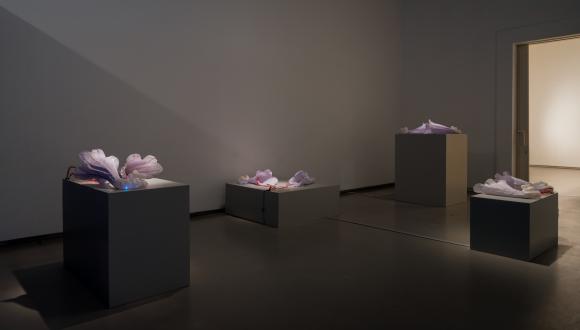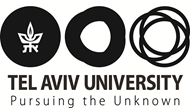Netaly Aylon, Moving Matters, 2024
Netaly Aylon (B. 1987)
Moving Matters, 2024
Kozo paper installation, handmade silk paper, brass wires, LED light system, cables and Raspberry PI computer.
Netaly Aylon’s work is the product of a dialogue between the artist and Prof. Ilit Ferber (Department of Philosophy), who studies experiences of physical and emotional pain and their connection with questions concerning language, expression and empathy. Ferber’s research seeks to challenge the accepted belief that pain is an extreme and lonely experience, impossible to communicate by means of language, thus creating an insurmountable gap between the person in pain and those surrounding them. Ferber has also studied the importance of the sense of hearing to verbal communication and the forging of human connections. Influenced by the 18th-century philosopher Johan Gottfried Herder, Ferber notes that although at times we initially recoil from other people’s pain, the prelinguistic expression of distress through sounds, as well as our ability to respond to it, are traits that cut across species, enabling us to express empathy and participate in another’s pain. Even when we do not fully understand them, expressions of distress (screaming, wailing, crying) can deeply affect our world, provoking an empathic resonance that goes beyond explicit, verbal modes of communication.
Building on these insights, Aylon explores the possibility of awakening and expanding empathy between the human and the nonhuman, natural world, while observing pain as a state of exposure. Her work invites us to draw closer in order to “hear” a pulsating, voiceless presence. Aylon, who studies morphological shapes as states of connection between the human body, nature, and celestial phenomena, has created a sculptural installation concerned with communication and empathic synchrony between fragile bodies. Her work was inspired, among other things, by 19th-century analog hearing aids, which served as an intermediate object expanding the limits of human perception. This series of hybrid objects combines acoustic forms that move between the natural world and the human body: the funnel-shaped petals of the flower Judean viper's bugloss, alongside the cochlea, a spiral-shaped cavity in the inner ear. The flower opens out to the world and attempts to capture it, while the cochlea allows for external sounds to resonate within its internal space. As part of her study of structures, shapes, and their poetics, Aylon has created a form that simultaneously expands inward and outward. This structure, with its delicate, transparent skin, is comprised of an exposed mechanism and a fragile shell that both contain and resonate with the stimuli they receive. The shafts of light pulsating from within the objects convert sound frequencies that are not heard by the human ear, yet which attest to a living presence. The objects open up, turn to one another, and occasionally synchronize as they appeal to us to listen.
The dialogue between Ferber and Aylon concerning the fundamental loneliness of coping with pain and its implications has given rise to a series of works that explore the double face of pain: its existence as a private, self-enclosed experience, alongside the possibility of communicating it by means of sound, encouraging an empathic connection. At the same time, the turn from the human world to the natural world allows for a rethinking and expansion of this connection.
.jpg)
The work was made possible thanks to the support of the OUTSET Israel Foundation


